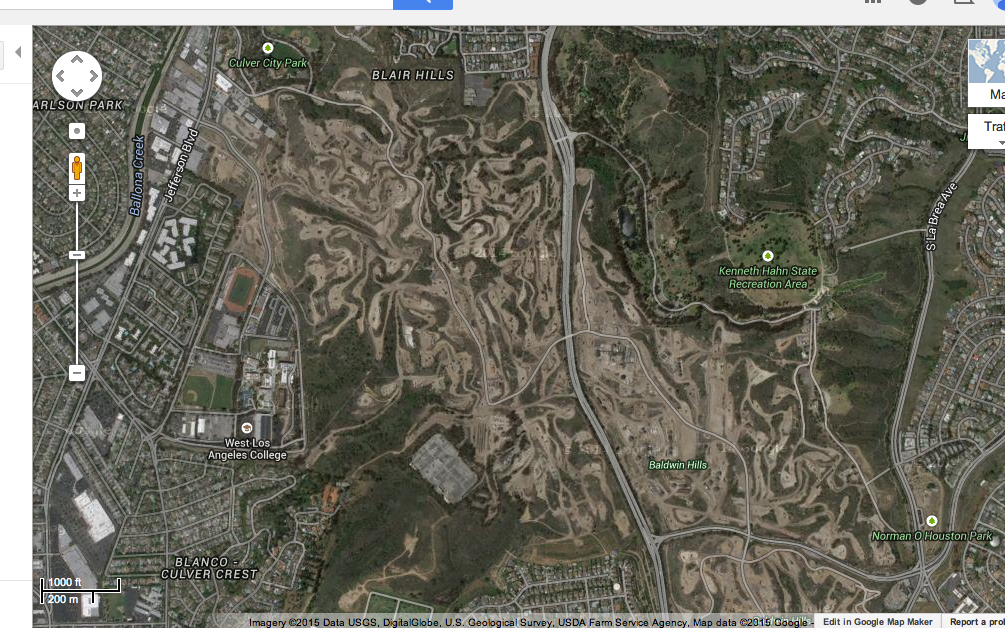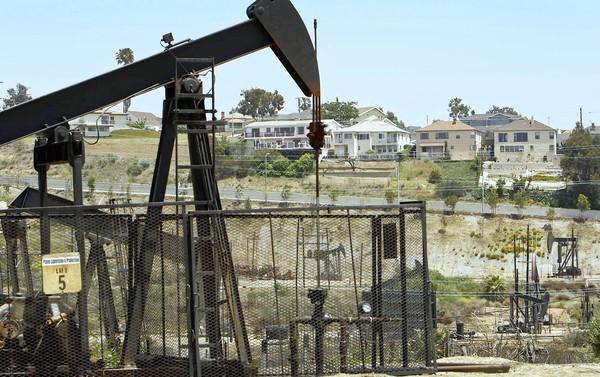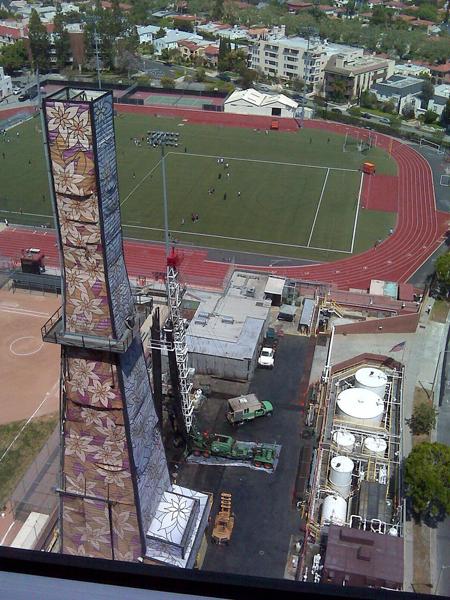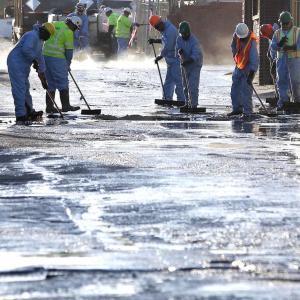by:Arlo Bender-Simon
While Kern County is home to over 75% of California’s fossil fuel production and the Bay area is California’s hub for social justice activism, Los Angeles County is home to millions of people living right next to oil and gas operations.
Part 2: The Fight Against Fracking In The Los Angeles Area
In February of 2014, the LA city council voted to draft legislation that would place a temporary ban on hydraulic fracturing and acidization. While city residents still wait to see any such draft legislation, anti-fracking momentum is growing.
Hydraulic Fracturing is a technique that has gained notoriety over the last decade for its role extracting natural gas; yet here in California, we frack for oil. “Fracking” is a fossil fuel extraction technique that involves high-pressure injection of water, sand and chemicals to fracture/crack apart formations of petroleum-bearing shale rock deep beneath the ground in order to release the oil and gas trapped within. “Acidizing” is a similar technique that relies on a much more intense chemical mixture to dissolve, rather than fracture the rock formation. These, and other “well stimulation treatments” are the same in that they require massive amounts of water to be injected underground to effectively lubricate the oil out of the ground….and they are both being employed in Los Angeles county.
We are learning that the injection of huge amounts of water underground can increase seismicity, causing the historically stable state of Oklahoma to challenge California for reputation as state with the most earthquakes. But what occurs much closer to the surface may be more troubling.
The wells that extend down to the rock formations pass through groundwater aquifers, which are a major source of drinking water. All it takes is one crack in the cement well casing for oil and fracking chemicals to begin leaking into these aquifers. At the surface, production facilities spew air pollution and are hubs of high volumes of truck traffic.
To top it all off, the water that is injected to stimulate the formation returns to the surface with the produced oil. Not only does it still contain the chemicals it was injected with, this water has now been mixed with all the toxicity associated with oil as well as naturally occurring radiation from deep underground. This water must be disposed of somewhere, most likely via an injection well, adding to the risks of groundwater contamination with more opportunity for well casing failure.
These risks, and more, have prompted hundreds of communities across the country to enact bans on well stimulation.
City Of LA Is Not Alone!
When the city council voted back in February, they made LA the largest city in the USA to ban fracking within its jurisdiction (though this is yet to be enforced). Los Angeles is not alone in this struggle, not even within LA County.
Culver City[1]
Culver City sits just west of the largest urban oil field in America[2]. The Baldwin Hills/Inglewood Oil field takes up over 1000 acres; fracking has been ongoing at this field for at least ten years.
Though both Culver City and the Inglewood Oil field are surrounded by the city of Los Angeles, they are outside city limits and under jurisdiction of the county government. In 2008, the LA County Board Of Supervisors adopted the Baldwin Hills Community Standards District to address the “special problem” that is the largest urban oil field in the country.


Figure 4 Inglewood/Baldwin Hills Oil Field (google maps); Homes within sight nearby[3].
The Culver City government has also taken its own action. In 2009 the city council enacted a moratorium on fracking. Though very little oil production at the neighboring oil field occurs within Culver City limits, there was enough to prompt PXP (the field’s operator at the time) to file suit against the law. The moratorium was upheld in court and lasted until 2011. Culver City is now considering a fracking ban of its own.
Carson
The city of Carson is home to over 90,000 people, an Ikea and the Los Angeles Galaxy, a soccer team that plays in a stadium on the California State University, Dominguez Hills campus; it is also home to significant amounts of fossil fuel production, as well as pieces of three separate refineries operated by Tesoro, BP, and Phillips66.
In March 2014, this city decided to take a stand against the fossil fuel industry when its city council enacted a 45-day moratorium on all oil and gas activity within its jurisdiction. Not only did this make the news, it grabbed attention. This was no mere attempt to prevent the spread of a few specific techniques; this was a city making moves to oust fossil fuel production altogether.
The city council failed to extend the moratorium when it came up for a vote again in April 2014[4]. Since then, they have been looking into rewriting the city ordinances governing oil and gas activity, a significantly less radical path; one the LA city council is also considering.
(There are two other bits from Carson I would like to mention:
-In January 2015, it was announced that a former subsidiary of Occidental Petroleum was pulling out of a drilling project that would have brought over 200 new wells to Carson. The cited reason was the drop in oil prices; we know that were it not for the committed opposition of residents, the project would have been well underway by now.
-The Carson refinery operated by Tesoro is one of 15 current targets of a nationwide strike called by the United Steel Workers, a union representing workers in the oil, gas and chemical industries. On February 1, workers at nine refineries walked off the job; the strike has since expanded to six more facilities. The demands of the union highlight the inherent dangers of this industry. Here is a quote from a letter to USW Oil Workers posted on the union’s website:
“We shouldn’t be expected to work long hours for weeks on end without a break. We shouldn’t be expected to work in places where, on average, we have a fire every week of the year. We shouldn’t be expected to work in places where equipment is old and in need of maintenance, but the company considers too costly to take off line and fix properly because it might slow production.
We shouldn’t have to sacrifice quality time with our families by working shifts and schedules that never end. We end up too exhausted to do anything other than grab a few hours’ sleep before heading back to work. We have the right to insist on better conditions.[5]”
Compton
On April 22, 2014, Compton joined the struggle when its city council voted to ban all well stimulation treatments within city limits. They took a step further, into shaky legal territory, by including all well bores that passed underneath city limits, which makes some amount of sense given that most well stimulation treatments (aka fracking and acidizing) occur in wells that have been drilled horizontally to access a specific layer of rock that is essentially one pancake in a stack of many.
Unfortunately, under California state law, municipalities do not have authority to regulate sub-surface activity; this lies with the state government[6]. In July, the Western States Petroleum Association (WSPA) sued the city of Compton over this specific issue. Rather than stand up to the most powerful fossil fuel lobby in the state, the Compton city government decided to back down. In early October the city council voted unanimously to drop the ban and in late November WSPA dropped the lawsuit.
Beverly Hills
On May 6th, the Beverly Hills city council approved an ordinance that bans well stimulation from future use in city limits. Though Compton voted first, the Beverly Hills law has not yet been challenged in court, making it the first city in the state to enact a ban on fracking, acidizing, and other well stimulation treatments. While the three other cities mentioned in this section have been thus far unable to follow through with their own ban attempts, Beverly Hills is now months into its status as a “frack-free” zone.


Figure 5 (left) Drilling Next To Beverly Hills High School[7] Figure 6 (right) Cleaning the Oil spill in Atwater Village[8]
Guess What…Oil & People Don’t Mix Well
Where were you on May 15th, 2014? February 18th, 2015?
If you were in Atwater Village, or Torrance, you were given a shocking reminder of how pervasive our dependence on fossil fuels is and how big of an impact it can have when something goes wrong.
Atwater Village is on the edge of LA city limits in between Glendale and East Hollywood. For residents, May 15th, 2014 began with the realization that their streets were flooded with oil. Overnight a pipeline running beneath the city had ruptured and spewed roughly 10,000 gallons aboveground.
Torrance is a city in LA county neighboring Carson and home to a refinery operated by ExxonMobil. On February 18, 2015, a pressure buildup inside the refinery caused an explosion that jolted the surrounding area like a small earthquake. Luckily, noone was killed but this is not a freak occurrence. Refineries are inherently dangerous given that they are constantly dealing with extreme temperatures and pressures while maintaining and containing a toxic mixture of explosive chemicals.
These are reminders for all of us that the problems with fossil fuels are not only the new techniques we use to extract them, but the aging infrastructure that transports them (trucks, pipelines, trains), the hazardous facilities that process them, and the fact that fossil fuels are toxic and do not mix with a healthy living being. We need to keep fossil fuels below ground; We’ve got plenty of sun up here! No need to bring that dirty energy up to the surface with us.
If you live in California, there is probably a local effort to ban fracking, or otherwise protect communities from fossil fuel exploitation, near you. They need help!
Stay tuned: the final segment of this will be coming in the next few weeks and will discuss recent election results of California fracking ban attempts.
References
[1] Lynee Bronstein, Council Proceeds Cautiously On Fracking Ban, Culver City Observer, http://www.culvercityobserver.com/story/2014/04/03/news/council-proceeds-cautiously-on-fracking-ban/3677.html, April 3, 2014. (accessed 12/13/14)
[2] Dina Demetrius & Jennifer London, The ‘F’ Word: Unregulated Fracking At Oil Wells Raises Concerns, KCET Los Angeles: SoCal Connected, http://www.kcet.org/shows/socal_connected/content/environment/the-f-word-unregulated-fracking-at-oil-wells-raises-concerns.html, March 23, 2012. (accessed December 10, 2014)
[3] photo taken from: Oct. 10, 2012 LA Times article, Inglewood Oil Field Fracking Study Finds No Harm From The Method, by Ruben Vives, http://articles.latimes.com/2012/oct/10/local/la-me-fracking-baldwin-hills-20121010. (accessed 12/14/14)
[4] Christine Mai-Duc, City Of Carson Changes Mind On New Oil Drilling Ban, LA Times, May 1, 2014, http://touch.latimes.com/#section/-1/article/p2p-80079386/. (accessed 12/27/14)
[5] United Steel Workers, Letter To USW Oil Workers, http://www.usw.org/union/mission/industries/oil/bargaining/letter-to-usw-oil-workers (accessed 3/1/15)
[6] Jeffrey Dintzer & Natheniel P. Johnson, Calif. Anti-Fracking Ordinances On Shaky Legal Ground, Law360, http://www.gibsondunn.com/publications/Documents/DintzerJohnson-CalifAnti-FrackingOrdinancesOnShakyLegalGround.pdf, August 29, 2014. (accessed 12/14/14)
[7] photo taken from: July 16, 2013 Getty Iris article, Subterranean LA: The Urban Oil Fields, by Cheryl Preston, http://blogs.getty.edu/iris/subterranean-l-a-the-urban-oil-fields/. (accessed 12/14/14)
[8] photo taken from: May 15, 2014 Sandusky Register article, 10,000 Gallons Of Oil Spill On Los Angeles Streets, by Associated Press, http://www.sanduskyregister.com/article/5638851. (accessed on 12/14/14)
